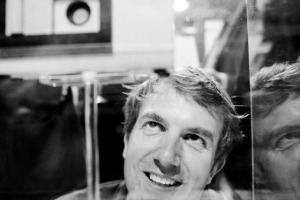Patagonia through a pinhole
Nick Livesey is best known as an Emmy-nominated maker of short films and documentaries. But he’s also a leading exponent of the art of pinhole photography. Nick Smith hears his story…
A Lancastrian, Nick left school at 16 and went to his local art college in Blackburn. At the age of 19 he was accepted by the Royal College of Art and became on of the youngest ever to graduate with an MA. He moved to New York for a year where he started making moving images, as well as embarking on a career with Ridley Scott Associates that represents him to this day.
Although widely known for his short films, commercials and documentaries, Nick is an avid exponent of the pinhole technique. His camera is ‘a bunch of MDF’ that cost him about £40, put together by a ‘garden shed genius.’ On his extended honeymoon he took this camera around Chile, trekking for days off the beaten track. The result was the intriguing and popular ‘Patagonia through a Pinhole’ exhibition at the Royal Geographical Society.
With pinhole photography ‘you’re at the mercy of the elements’ says Nick. And although he’s equally comfortable with digital technology, there’s something about the stripped-down aspect of using basic wooden boxes with film in them that he likes. ‘It’s such a basic communication and fundamental way of composing images.’
Nick Smith: When did you realise you were going to become a photographer?
Nick Livesey: It was more of a quest. I was frustrated and wanted to understand light while I was making films. I was working with Directors of Photography and was really curious as to what they were doing.
NS: What was your first camera?
NL: Nikon FG-20 that I bought at a flea market in New York in 1993. It felt like an investment. It was something like $130. It’s just a great 35mm camera.
NS: What formal training do you have?
NL: I went to the Royal College of Art where I did an MA in graphic design and art direction. I pretty much lived in the dark room when I was there. At the end of the first year they asked me if there was any reason why I wasn’t working in colour. They said ‘why don’t you work in colour in your second year?’ So I did.
NS: How important is it to specialise?
NL: It’s great to specialise to the extent that you can get a handle on the subject. But I do like working in so many different areas. If you specialise too much you can start to wear blinkers.
NS: What is the best assignment you’ve been on?
NL: I did a pinhole piece for a fashion magazine in Moscow. That really freaked out the fashion label. They kept saying ‘we need to see stuff’ and we kind of said ‘well we’ll send you a contact sheet.’
NS: What’s the worst thing about being a professional photographer?
NL: There’s no downside. There are so many plus factors. Maybe it would be nice to not smell of dark room chemicals. So you do have to wash occasionally.
NS: Film or digital? Why?
NL: They complement each other. I’m looking into ways of cutting the front off an Ixus and replacing it with a pinhole. I think it would be interesting to see what you could get with a digital pinhole.
NS: What’s the most important thing you’re learned from another photographer?
NL: Just stand back from it all. Get close to the subject when you’re shooting it, but when you’re arranging a show, learn to stand back from it all. Try to look at everything in its entirety.
NS: What does photography mean to you?
NL: I feel like a conduit. I love taking photographs, but the only point of that is if people want to see them. I’ve always been hungry for creating images. I also love the quiet world of the dark room.
NS: What makes a great travel photograph?
NL: It’s all about the reaction of the person viewing it. If you can see someone’s reaction to your photo in a detached way – say at a show – then you’ll know what they really think.
In Nick’s gadget bag
Cameras: Wooden pinhole camera, Canon 7D, Arri 435 (movie camera), Red and Sony (digital movie cameras)
To see more of Nick Livesey’s photography visit www.nicklivesey.com
Tags: Nick Livesey, nicksmithphoto, Outdoor Photography, Outdoor Photography magazine, Patagonia, Photographer, Photographer interview, pinhole camera, Royal Geographical Society, Travel Photography

May 31, 2012 at 11:45 am |
Interesting piece Nick (Smith). I built the camera that Nick Livesey is looking at in your photograph & was delighted to see it!
Tony